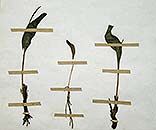Ophioglossum polyphyllum A.Braun [aggregate]
Synonyms |
Ophioglossum vulgatum L. var. polyphyllum (A. Braun) Milde |
|---|---|
Common name |
|
Description |
Rhizome spindle-shaped to linear, (6-)14-18(-70) mm long, 2-4 mm wide; roots fleshy, horizontal but sometimes descending, proliferous; persistent leaf bases present at the top of the rhizome. Leaves 1 to 2, held at 70-80% from the horizontal. Stipe (18-)40-65(-107) mm long, 40–60% of its length subterranean; stipe:lamina lenght ratio 0.8-1.5:1, old stipe bases persistent. Sterile lamina (20-)34-52(-60) × (7-)12-17(-30) mm, grey or glaucus green, narrowly elliptic to narrowly ovate, length:width ratio 1.4–4.5:1 (5-10.5:1 in var. angustifolium), apex pointed, mucronate, occasionally rounded, base wedge-shaped, texture rather fleshy, venation obscured in live material. Fertile spike 40–100 mm long, with 12–30 pairs of sporangia; fertile spike:lamina ratio 1.2-2.4:1. |
Notes | O. polyphyllum is easy to recognise by the cluster of dried leaf petioles at the top of the rhizome. Recently 2 varieties have been distinguished: var. polymorpha (width:length ratio 1:1.4-4.5) and var. angustifolium (width:length ratio 1:5-10.5) |
Derivation | polyphyllum: with many leaves |
Habitat | Growing in various habitats (open grasslands, deciduous woodlands, rocky outcrops, soils overlying sheetrock, alluvial soils near rivers, ..) but absent from forests. |
Distribution worldwide | Africa, Saudi Arabia, Afghanistan, India, Cape Verde Isl., Canary Isl. and St. Helena. |
Distribution in Africa |
Algeria, Angola, Botswana, Burundi, Chad, Dem. Republic of Congo, Djibouti, Egypt, Ethiopia, Ghana, Kenya, Lesotho, Malawi, Morocco and Western Sahara, Mozambique, Namibia, Somalia, South Africa, Sudan and South Sudan, Tanzania , Uganda, Zimbabwe. |
Growth form |
Terrestrial. |
Literature |
|


